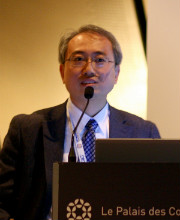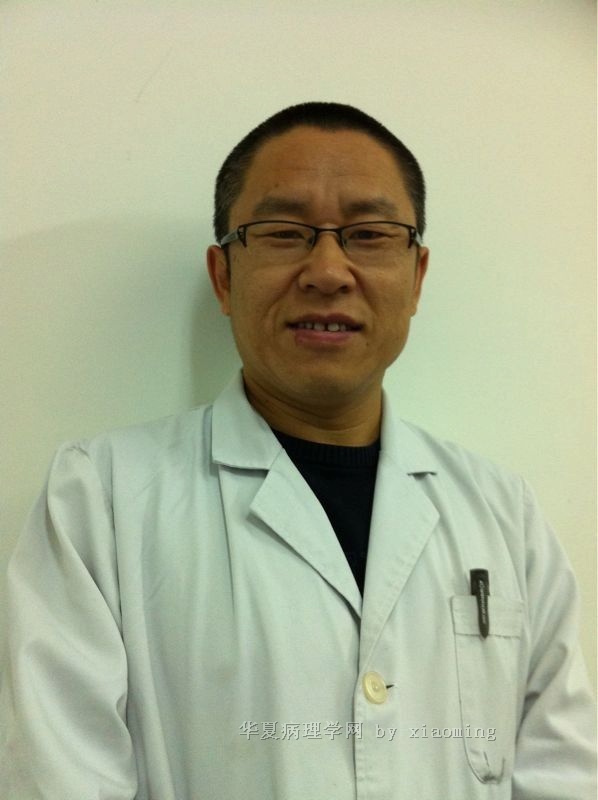| 图片: | |
|---|---|
| 名称: | |
| 描述: | |
- 2010美国病理学年会摘要翻译(骨和软组织)
-
CD1a Immunopositivity in Perivascular Epithelioid Cell Neoplasms (PEComas): True CD1a Expression or Technical Artifact?
WA Ahrens, AL Folpe. Carolinas Medical Center, Charlotte, NC; Mayo Clinic, Rochester, MN.
Background: PEComas comprise a family of rare neoplasms composed of morphologically distinctive perivascular epithelioid cells exhibiting a “myomelanocytic” immunophenotype. The distinction of PEComas from other tumors with melanocytic and smooth muscle differentiation can be difficult. A recent study has claimed that PEComas routinely express CD1a, a Langerhans cell-associated transmembrane glycoprotein involved in antigen presentation, and that expression of this marker may be helpful in the distinction of PEComas from various mimics. We evaluated a series of PEComas and potential mimics for CD1a expression.
Design: A total of 54 cases (27 PEComas; 11 leiomyosarcomas; 10 melanomas; 6 clear cell sarcomas) were evaluated in 2 laboratories (Laboratory A: 31 cases, Laboratory B 23 cases). Nine Laboratory B cases were retested at Laboratory A. Laboratory A methods: MTB1 clone (1:20, Novocastra), heat-induced epitope retrieval in EDTA (pH 8.0), Dako Advance detection system (Dako Corp.) with background reducing diluent.
Laboratory B methods: MTB1 clone (1:30, CellMarque), heat-induced epitope retrieval in Medium Cell Conditioner #1 (pH 8.0–9.0), streptavidin-biotin detection system with DAB chromogen. Scoring: 1+, 5-25%; 2+, 26-50; 3+, >51%. Langerhans cells served as a positive internal control in all tested cases.
Results: All Laboratory A cases were negative. 16 Laboratory B PEComas (14 renal angiomyolipomas, 1 soft tissue PEComa, 1 pulmonary clear cell “sugar” tumor) showed CD1a immunopositivity (1+: 7 cases; 2+: 7 cases; 3+: 2 cases). All non-PEComas were negative. All positive PEComas showed cytoplasmic staining only, without membranous staining. The 9 Laboratory B positive PEComas were negative when retested at Laboratory A.
Conclusions: We conclude that PEComas do not truly express CD1a in a biologically plausible membranous pattern, but may instead show aberrant cytoplasmic immunopositivity in some laboratories. Close inspection of published photomicrographs of previously reported CD1a-positive PEComas shows an identical pattern of cytoplasmic positivity. This aberrant pattern of immunopositivity likely reflects a
technical artifact related to epitope retrieval and detection methods. Alternatively, this staining could represent cross-reactivity with an epitope unique to PEComas, as it was not observed in non-PEComas. Ultimately, however, we do not believe there is a real role for CD1a immunohistochemistry in the differential diagnosis of PEComas.
-
Novel EWSR1-POU5F1 Fusion in Soft Tissue Myoepithelial Tumors. A Molecular Analysis of 29 Cases, Including Soft Tissue, Bone and Visceral Locations Showing Common Involvement of EWSR1 Gene
Rearrangement
CR Antonescu, L Zhang, NE Chang, BR Pawel, W Travis, AE Rosenberg, GP Nielsen, P Dal Cin, CD Fletcher. Memorial Sloan-Kettering Cancer Center, New York, NY; The Children’s Hospital of Philadelphia, Philadelphia, PA; Massachusettes General Hospital, Boston, MA; Brigham&Women’s Hospital, Boston, MA.
Background: The diagnosis of myoepithelial tumors (MET) outside salivary glands remains challenging, especially in unusual clinical presentations, such as bone or visceral locations. Few reports have indicated an EWSR1 gene rearrangement in soft tissue MET, and, in one case each, the fusion partner was identified as being either PBX1 or ZNF444. However, larger studies to investigate if these genetic abnormalities are recurrent or if restricted to the soft tissue location are lacking.
Design: 29 MET from mainly soft tissue, but also bone & visceral locations, showing classic morphologic features and supporting immunoprofile, with available tissue were included for molecular analysis. Patient age ranged from 1-70 years old. Gene rearrangements in EWSR1, PBX1 and ZNF444 were investigated by FISH. In 2 cases with EWSR1 rearrangement and frozen tissue available, 3’RACE was performed to
identify potential novel fusion partners.
Results: EWSR1 gene rearrangement by FISH was detected in 59% cases. A novel EWSR1-POU5F1 was identified in a pediatric soft tissue MET by 3’RACE and subsequently confirmed in 2 additional soft tissue tumors in young adults, but not in other locations. The presence of a EWSR1-PBX1 was seen in one soft tissue tumor, while EWSR1-ZNF444 was noted in one pulmonary MET.
Conclusions: EWSR1 gene rearrangement is a common event in MET irrespective of their anatomic location. Many of the EWSR1 negative tumors were superficial lesions, suggesting the possibility of genetically distinct groups. A subset of soft tissue MET harbor a novel EWSR1-POU5F1 fusion, which can be used as a molecular diagnostic test in difficult cases.
A Subset of
P Argani, P Illei, G Netto, J Ro, HY Cho, S Dogan, M Ladanyi, G Martignoni, S Aulmann,
SW Weiss. Johns Hopkins Medical Institutions, Baltimore, MD; Asan Medical Center, Seoul, Korea; Memorial Sloan-Kettering Cancer Center, New York, NY; University of Verona, Verona, Italy; University of Heidelberg, Heidelberg, Germany; Emory
University,
Background: Perivascular epithelioid cell neoplasms (PEComas) include the common renal angiomyolipoma, pulmonary clear cell sugar tumor and lymphangioleiomyomatosis, and less common neoplasms of soft tissue, gynecologic and gastrointestinal tracts. Recently, aberrant immunoreactivity for TFE3 protein (a sensitive and specific marker of neoplasms harboring TFE3 gene fusions) has been reported in as many as 80% of PEComas. TFE3 gene status in these neoplasms has not been systematically investigated, though a recent case report has documented a PSF-TFE3 gene fusion in an extrarenal PEComa.
Design: We used a fluorescence in situ hybridization (FISH) break-apart assay to evaluate for TFE3 gene fusions in archival material from 26 PEComas. These cases included 2 previously published TFE3 immunoreactive non-renal PEComas, 12 additional non-renal PEComas (5 soft tissue, 4 abdominal, 2 uterine, 1 hepatic), and 12 renal angiomyolipomas with predominant spindle or epithelioid morphology. Results were correlated with TFE3 immunoreactivity and clinicopathologic features.
Results: Three non-renal PEComas (mean patient age 19 years) demonstrated TFE3 gene fusions by FISH; all three demonstrated strong positive (3+) TFE3 immunoreactivity. Two of these cases had adequate mRNA for RT-PCR analysis, and neither harbored a PSF-TFE3 gene fusion. In addition, a metastasis of a uterine PEComa which showed moderate positive (2+) TFE3 immunoreactivity demonstrated TFE3 gene amplification, a previously unreported phenomenon. None of the other 22 PEComas (mean patient age 54 years) demonstrated TFE3 gene alterations, though 4 demonstrated moderate positive
(2+) TFE3 immunoreactivity. All 4 PEComas with TFE3 alterations immunolabeled strongly for Cathepsin K, similar to other PEComas.
Conclusions: A subset of PEComas harbor TFE3 gene fusions. While numbers are small, distinctive features of these cases include young age, extrarenal location, absence of association with tuberous sclerosis (TS), predominant epithelioid clear cell morphology, minimal immunoreactivity for muscle markers, and strong (3+) TFE3 immunoreactivity. Despite significant morphologic overlap with other PEComas, PEComas harboring TFE3 gene fusions may represent a distinctive entity.
-
本帖最后由 于 2010-04-03 22:28:00 编辑
| 以下是引用njwbhuang在2010-4-3 11:15:00的发言: CD1a Immunopositivity in Perivascular Epithelioid Cell Neoplasms (PEComas): True CD1a Expression or Technical Artifact? |
CD
背景; PEComas是由免疫组织化学上表达肌源的黑色素细胞的血管周上皮样细胞构成的罕见肿瘤。PEComas与其他伴有平滑肌和黑色素细胞分化的肿瘤的区分很困难。最近研究发现PEComas常规表达CD1a,CD1a是一种郎格汉斯细胞相关的跨膜糖蛋白,参与抗原的递呈。CD1a的表达可能有助于PEComas与其相似肿瘤的区分。我们评估了CD1a在PEComas和其相似肿瘤中的表达。
设计:一共54例肿瘤(PEComas27例、平滑肌肉瘤11例、黑色素瘤10例、透明细胞肉瘤6例)分布在两个实验室进行了CD1a的检测(实验室A:31例,实验室B:23例)。9例实验室B的病例在实验室A进行了再次检验。实验室A的方法:克隆号为MTB1(1:20, Novocastra),高温抗原修复,修复液为EDTA (pH 8.0),检测系统为Dako先进的检测系统,背景染色弱。实验室B的方法:克隆号为MTB1(1:30, CellMarque),在中等细胞调节器中进行抗原修复#1 (pH 8.0–9.0),检测系统为链霉素生物素检测系统,DAB显色。CD1a结果判断为1+, 5-25%; 2+, 26-50; 3+, >51%。郎格汉氏细胞作为阳性内对照。
结果:实验室A中所有病例CD1a都为阴性,实验室B中16例(肾血管肌脂肪瘤14例、软组织PEComas1例、肺糖瘤1例)CD1a均表达阳性(+:7例、2+:7例、3+:2例)。所有非PEComas都不表达CD1a。所有阳性表达的PEComas都是细胞质着色,膜不着色。9例实验室B中CD1a表达阳性的病例在实验室A中检测时均表达阴性。
结论:我们推断PEComas并不是以一种生物学上似是而非的膜染色真正表达CD1a,而是在某些实验室可呈异常的胞质表达。仔细观察先前发表的表达CD1a的PEComas的显微照片可以看出都是细胞质染色。这种异常的免疫染色可能反映了与抗原修复和检测方法有关的一种技术误差。另外这种染色因不出现于非PEComas里,可能代表着PEComas特有抗原的交叉反应。最后我们不认为CD1a免疫组化在PEComas鉴别诊断中具有实际作用。

- 刀锋上的蚂蚁
A Subset of
P Argani, P Illei, G Netto, J Ro, HY Cho, S Dogan, M Ladanyi, G Martignoni, S Aulmann,
SW Weiss. Johns Hopkins Medical Institutions, Baltimore, MD; Asan Medical Center, Seoul, Korea; Memorial Sloan-Kettering Cancer Center, New York, NY; University of Verona, Verona, Italy; University of Heidelberg, Heidelberg, Germany; Emory
University,
Background: Perivascular epithelioid cell neoplasms (PEComas) include the common renal angiomyolipoma, pulmonary clear cell sugar tumor and lymphangioleiomyomatosis, and less common neoplasms of soft tissue, gynecologic and gastrointestinal tracts. Recently, aberrant immunoreactivity for TFE3 protein (a sensitive and specific marker of neoplasms harboring TFE3 gene fusions) has been reported in as many as 80% of PEComas. TFE3 gene status in these neoplasms has not been systematically investigated, though a recent case report has documented a PSF-TFE3 gene fusion in an extrarenal PEComa
在PEComas中TFE3基因融合物的表达
乔治亚州亚特兰大学
背景;血管周围上皮细胞瘤(PEComas)包括普通的肾脏血管肌脂瘤,肺透明细胞瘤,淋巴管肌瘤病,普通的软组织瘤,妇产科和胃肠道方面的肿瘤。TFE3蛋白(是一种敏感而特异的TFE3基因融合物的标志物)的异常免疫反应在80%PEComas中被报告,TFE3基因的地位在这些肿瘤中没有被系统性的研究,尽管最近的一个病例报告明确指出PSF-TFE3基因融合物在肾外PEComas中出现

- there is no reason not to follow ur heart
Conclusions: EWSR1 gene rearrangement is a common event in MET irrespective of their anatomic location. Many of the EWSR1 negative tumors were superficial lesions, suggesting the possibility of genetically distinct groups. A subset of soft tissue MET harbor a novel EWSR1-POU5F1 fusion, which can be used as a molecular diagnostic test in difficult cases.
结论:EWSR1基因重排在任何解剖位置的肌上皮瘤中都共同存在。多数的EWSR1阴性的肿瘤有浅表损害,提示不同遗传群体的可能性。这组软组织肌上皮瘤包含异常的EWSR1-POU5F1融合,在诊断困难的病例中可以用来作为分子诊断的指标.

- 刀锋上的蚂蚁
A Subset of
少数PEComas具有TFE3基因融合
Background: Perivascular epithelioid cell neoplasms (PEComas) include the common renal angiomyolipoma, pulmonary clear cell sugar tumor and lymphangioleiomyomatosis, and less common neoplasms of soft tissue, gynecologic and gastrointestinal tracts. Recently, aberrant immunoreactivity for TFE3 protein (a sensitive and specific marker of neoplasms harboring TFE3 gene fusions) has been reported in as many as 80% of PEComas. TFE3 gene status in these neoplasms has not been systematically investigated, though a recent case report has documented a PSF-TFE3 gene fusion in an extrarenal PEComa.
背景:血管周上皮样细胞肿瘤(PEComas)包括常见的肾血管肌脂肪瘤、肺透明细胞糖瘤和淋巴管肌瘤病,以及发生于软组织、妇科和胃肠道少见的肿瘤。最近有报道TFE3蛋白(TFE3基因融合的肿瘤一种敏感性和特异性标记物)可在80%PEComas中异常表达。尽管近来有PSF-TFE3基因融合的肾外PEComa的病例报道,但这些肿瘤中TFE3基因改变还未系统研究。
Design: We used a fluorescence in situ hybridization (FISH) break-apart assay to evaluate for TFE3 gene fusions in archival material from 26 PEComas. These cases included 2 previously published TFE3 immunoreactive non-renal PEComas, 12 additional non-renal PEComas (5 soft tissue, 4 abdominal, 2 uterine, 1 hepatic), and 12 renal angiomyolipomas with predominant spindle or epithelioid morphology. Results were correlated with TFE3 immunoreactivity and clinicopathologic features.
设计:我们使用FISH断裂法研究了26例PEComas中TFE3基因融合状况。这些病例中包括2例以前报道的TFE3阳性的肾外的PEComas,12例另外的非肾脏的PEComas(软组织5例、腹部4例、子宫2例和肝脏1例)和12例以梭形细胞或上皮样细胞形态为主的肾血管肌脂肪瘤。同时将FISH检测结果与TFE3免疫组化结果和临床病理特征进行分析。
Results: Three non-renal PEComas (mean patient age 19 years) demonstrated TFE3 gene fusions by FISH; all three demonstrated strong positive (3+) TFE3 immunoreactivity. Two of these cases had adequate mRNA for RT-PCR analysis, and neither harbored a PSF-TFE3 gene fusion. In addition, a metastasis of a uterine PEComa which showed moderate positive (2+) TFE3 immunoreactivity demonstrated TFE3 gene amplification, a previously unreported phenomenon. None of the other 22 PEComas (mean patient age 54 years) demonstrated TFE3 gene alterations, though 4 demonstrated moderate positive (2+) TFE3 immunoreactivity. All 4 PEComas with TFE3 alterations immunolabeled strongly for Cathepsin K, similar to other PEComas.
结果:3例非肾PEComas(平均年龄19岁)FISH检测证实有TFE3基因融合,且所有TFE3免疫组化均为强阳性(3+),其中2例有足够的mRNA可用以RT-PCR分析,但均未见PSF-TFE3基因融合。另外,转移性子宫PEComaTFE3免疫组化为中等阳性(2+),且有TFE3基因扩增,该现象以前未见报道。其他22例PEComas(平均54岁)中有4例TFE3免疫组化为中等阳性(2+),但均未见TFE3基因扩增。所有4例伴有TFE3改变的PEComas均强阳性表达Cathepsin K,与其他PEComas相同。
Conclusions: A subset of PEComas harbor TFE3 gene fusions. While numbers are small, distinctive features of these cases include young age, extrarenal location, absence of association with tuberous sclerosis (TS), predominant epithelioid clear cell morphology, minimal immunoreactivity for muscle markers, and strong (3+) TFE3 immunoreactivity. Despite significant morphologic overlap with other PEComas, PEComas harboring TFE3 gene fusions may represent a distinctive entity.
结论:有一些PEComas具有TFE3基因融合。虽然这部分病例数量少,但它们具有独特的临床病理特征如年轻、肾外发生,缺乏相关的结核性硬化症(TS)、主要以上皮样透明细胞形态,很少表达肌源性标记物和TFE3免疫组化强阳性(3+)等。虽然形态学上与其他PEComas有明显的重叠,但TFE3基因融合的PEComas可能为一种独特的疾病实体。
Chondroblastoma-Like Osteosarcoma: A Clinicopathologic Review of 17 Cases
A Bahrami, K Unni, F Bertoni, P Bacchini, H Dorfman, T Nojima, C Inwards. Mayo
Clinic, Rochester; Casa di Cura Villa Erbosa, Bologna, Italy; Montefiore Medical Center, New York; Kanazawa Medical University, Uchinada, Japan.
Background: Chondroblastoma-like osteosarcoma (CBL-like OS) is an exceedingly rare histologic variant of OS that morphologically simulates CBL. Although this subtype is recognized in the WHO classification of bone tumors and bone pathology textbooks, there are only two documented cases in the literature.
Design: We conducted a clinicopathologic and radiographic review of 17 cases collected from 3 large consultative practices of OS showing histologic features resembling CBL. Histologic sections from the primary tumor (all cases) and pulmonary metastases (2 cases) were reviewed. Radiographic information was available on 13 cases.
Results: The tumors occurred in
Conclusions: We confirmed a subtype of OS resembling CBL. In a tumor with cytologic features similar to CBL, histologic evidence of destructive growth and/or abnormal pattern of bone production should raise the possibility of CBL-like OS, particularly if the tumor is located in an unusual site for CBL or has radiographic findings suggesting malignancy
A Pro-Inflammatory Tumor Microenvironment with High Chemokine Expression and High Tumor-Infiltrating CD3+CD8+ Numbers Associates with Improved Survival in
D Berghuis, SJ Santos, JJ Baelde, AHM Taminiau, RM Egeler, MW Schilham, PCW
Hogendoorn, AC Lankester.
Background: Despite multimodal therapy, patients with advanced-stage EWS have a poor prognosis. Immunotherapeutic strategies may provide novel treatment modalities. Although EWS cells can be recognized and targeted by T and NK cells in vitro, limited information is available about tumor-immune interactions within the tumor microenvironment. Here we investigate characteristics of the immune cell infiltrate and chemokine expression in EWS, as well as their mutual relationship and correlations with clinicopathological parameters.
Design: EWS tumors (n=20) were evaluated by quadruple immunohistochemistry for presence and spatial distribution of tumor-infiltrating lymphocytes (TIL; CD3+/CD4+/ CD8+). Chemokine expression was analyzed in both tumors and cell lines (n=9) by qRT-PCR, immunohistochemistry and flow cytometry.
Results: Substantial inter-tumor variations were observed for both numbers and distribution (tumor- or stroma-infiltrating) of TIL as well as for chemokine expression profiles. Tumor-infiltrating T-cells contained higher percentages of CD3+CD8+ cells as compared to stroma-infiltrating cells (p=0.04). Moreover, survival analysis revealed prognostic benefit of a more robust CD3+CD8+ T-lymphocytic infiltrate (p=0.04). Positive correlations between gene expression levels of several functionally related, proinflammatory chemokines (mainly CCR5-/ CXCR3-ligands) and TIL numbers (p<0.05) suggested that expression of these chemokines contributed to TIL recruitment. The presence of both constitutive and IFNã-inducible expression of several pro-inflammatory chemokines (CCL5, CXCL9, CXCL10) was confirmed at protein level. High chemokine expression levels, like the presence of high tumor-infiltrating CD3+CD8+ cell numbers, associated with improved overall survival (p=0.03).
Conclusions: These results demonstrate prognostic benefit of a tumor microenvironment with high levels of pro-inflammatory chemokines as well as high numbers of tumorinfiltrating CD3+CD8+ T-lymphocytes and point to a role for adaptive anti-tumor immune responses in prevention of tumor progression.
-
Adult Fibrosarcoma (FS): A Reevaluation of 154 Putative Cases Diagnosed at a Single Institution over a 48 Year Period
成人型纤维肉瘤(RS):一个研究结构48年期间154例有争议病例的重新评价
A Bahrami, AL Folpe. Mayo Clinic,
Background: Adult FS, defined by the WHO as a “malignant tumor, composed of fibroblasts… and, in classical cases, a herringbone architecture” was once considered the most common adult sarcoma. Currently FS is regarded as a diagnosis of exclusion, representing only 1-3% of adult sarcomas. This trend is likely due to: 1) widespread use of immunohistochemistry (IHC) and molecular diagnostic techniques, 2) recognition of distinct FS subtypes, and 3) distinction of FS from undifferentiated pleomorphic sarcoma (UDPS). However, no recent series has critically re-evaluated putative FS, to estimate their true incidence.
背景:成人型FS,WHO定义为“由纤维母细胞组成的恶性肿瘤…,经典型病例呈鱼骨样结构”曾被认为是最常见的发生于成人的肉瘤。目前FS是作为一种排除性诊断,仅占成人肉瘤的1-3%。这种趋势可能是由于1)免疫组化和分子诊断技术的广泛应用,2)独特的FS亚型的确认和3)FS与未分化多形性肉瘤(UDPS)的区分。然而,近来没有系列研究对有争议的FS进行严格的重新评价而评估其真正的发生率。
Design: 178 cases diagnosed as adult FS in soft tissue locations were retrieved from
our institutional archives for the period 1960-2008. 24 cases with insufficient material were excluded. Based on the morphology of the final 154 cases, IHC was performed using some combination of: wide-spectrum CK, EMA, high molecular weight CK, S100, Melan A, HMB-45, CD34, CD31, TLE1, smooth muscle actin, desmin, Myo-D1, myogenin, c-kit, INI1, calretinin, WT1 and TTF1. Revised diagnoses were based on clinical, morphological, and IHC findings.
设计:收集我们研究结构在1960-2008年间诊断的软组织部位的成人FS178例。24例因标本量不足而除去。根据最后的154例病例形态学,我们使用了下面一组免疫标记:光谱CK、EMA、HMW-CK、S100、, Melan A、HMB-45、CD34、CD31、TLE1、SMA、desmin、Myo-D1、myogenin、c-kit、IN1、calretinin、WT1和TTF1。根据临床、形态学和IHC结果对原来的诊断进行了修改。
Results: The original group of putative FS occurred in
结果:原来诊断的FS男性81例,女性73例(发病年龄2-99岁,平均年龄53岁),发病部位分别为腿部(50例)、头/颈部(30例)、胸/腹腔(22例)、胳膊(21例)、纵膈(8例)、腹部/后腹膜/盆腔(13例)和肺(10例)。仅有22例符合WHO FS诊断标准。男性13例,女性9例(发病年龄6-74岁,平均49岁)。发生部位分别为腿部(11例)、头/颈部(6例)、胸/腹腔(2例)、纵膈(2例)和胳膊(1例)。132例非纤维肉瘤被重新分类为未分化多形性肉瘤(28例)、滑膜肉瘤(21例)、SFT(14例)、粘液性纤维肉瘤(10例)、MPNST(6例)、DFSP和促纤维增生性黑色素瘤(各4例),低级别纤维黏液样肉瘤、肉瘤样癌、硬纤维瘤、横纹肌肉瘤、肌纤维母细胞肉瘤、梭形细胞脂肪肉瘤(各3例),硬化性上皮样纤维肉瘤、纤维瘤样上皮样肉瘤、平滑肌肉瘤、富于细胞性纤维组织细胞瘤(各2例)以及其他肿瘤(9例)。
Conclusions: Using modern diagnostic criteria and ancillary IHC we have been able to reclassify 87% of putative FS. Exclusive of UDPS, the distinction of which from FS is subjective, 61% of putative FS were reclassified, most commonly as monophasic synovial sarcoma and solitary fibrous tumor. We conclude that true FS is exceedingly rare, accounting for <0.1% of ∼18,000 adult soft tissue sarcomas seen at our institution during this time period, and should be diagnosed with great caution
结论:使用现代诊断标准和免疫组化辅助技术,我们能对87%有争议饿FS重新分类。除了与未分化多形性肉瘤的区分是主观外,61%有争议的FS被重新分类,其中最常见为单向性滑膜肉瘤和孤立性纤维性肿瘤。我们认为真正的FS非常罕见,在此段时间内我们单位诊断的18,000成人软组织肉瘤的<0.1%。诊断FS应特别谨慎。
| 以下是引用njwbhuang在2010-4-4 21:51:00的发言:
A Pro-Inflammatory Tumor Microenvironment with High Chemokine Expression and High Tumor-Infiltrating CD3+CD8+ Numbers Associates with Improved Survival in D Berghuis, SJ Santos, JJ Baelde, AHM Taminiau, RM Egeler, MW Schilham, PCW Hogendoorn, AC Lankester. Background: Despite multimodal therapy, patients with advanced-stage EWS have a poor prognosis. Immunotherapeutic strategies may provide novel treatment modalities. Although EWS cells can be recognized and targeted by T and NK cells in vitro, limited information is available about tumor-immune interactions within the tumor microenvironment. Here we investigate characteristics of the immune cell infiltrate and chemokine expression in EWS, as well as their mutual relationship and correlations with clinicopathological parameters. Design: EWS tumors (n=20) were evaluated by quadruple immunohistochemistry for presence and spatial distribution of tumor-infiltrating lymphocytes (TIL; CD3+/CD4+/ CD8+). Chemokine expression was analyzed in both tumors and cell lines (n=9) by qRT-PCR, immunohistochemistry and flow cytometry. Results: Substantial inter-tumor variations were observed for both numbers and distribution (tumor- or stroma-infiltrating) of TIL as well as for chemokine expression profiles. Tumor-infiltrating T-cells contained higher percentages of CD3+CD8+ cells as compared to stroma-infiltrating cells (p=0.04). Moreover, survival analysis revealed prognostic benefit of a more robust CD3+CD8+ T-lymphocytic infiltrate (p=0.04). Positive correlations between gene expression levels of several functionally related, proinflammatory chemokines (mainly CCR5-/ CXCR3-ligands) and TIL numbers (p<0.05) suggested that expression of these chemokines contributed to TIL recruitment. The presence of both constitutive and IFNã-inducible expression of several pro-inflammatory chemokines (CCL5, CXCL9, CXCL10) was confirmed at protein level. High chemokine expression levels, like the presence of high tumor-infiltrating CD3+CD8+ cell numbers, associated with improved overall survival (p=0.03). Conclusions: These results demonstrate prognostic benefit of a tumor microenvironment with high levels of pro-inflammatory chemokines as well as high numbers of tumorinfiltrating CD3+CD8+ T-lymphocytes and point to a role for adaptive anti-tumor immune responses in prevention of tumor progression. |
临炎症与肿瘤微环境改良尤因肉瘤(EWS的生存与高趋化因子的表达和高肿瘤浸润外周血CD3 + CD8 +的编号协会)
Ð Berghuis,律政司司长桑托斯,杰杰巴尔德,AHM模型Taminiau,马币埃格勒,兆瓦Schilham,公众货物起卸区
Hogendoorn,交流兰克斯特。莱顿大学医学中心,莱顿,荷兰。
背景:尽管多式联运治疗的晚期病人有预警系统的预后较差。免疫治疗提供新的治疗策略可能方式。虽然预警系统细胞能够识别和T细胞和NK细胞在体外培养的目标,有限的信息是关于肿瘤微环境内的肿瘤免疫相互作用提供。在这里,我们探讨免疫细胞浸润与趋化因子的特点表现在预警系统,以及它们的相互关系,并与临床病理参数的关系。
设计:预警系统肿瘤(20例)是由对存在和肿瘤浸润淋巴细胞(TIL的空间分布翻两番免疫组织化学评估; /外周血CD4 + / CD8 +的外周血CD3 +)。趋化因子的表达,并分析了两种肿瘤细胞株(9例由实时定量RT - PCR技术,免疫组织化学和流式细胞仪)。
结果:大量的跨观察肿瘤的变化两个号码和分配(瘤或间质浸润的TIL)以及趋化因子表达谱。肿瘤浸润T细胞中的CD3 + CD8 +细胞比例较高,较基质浸润细胞(P = 0.04)。此外,生存分析揭示了一个更强大的外周血CD3 + CD8 + T细胞,淋巴细胞浸润性(P = 0.04预后的利益)。基因表达水平之间呈正相关的几个功能相关,炎性趋化因子(主要的CCR5 - / CXCR3的配体)和TIL数(P <0.05)建议,这些趋化因子的表达促进TIL的招聘。这两个构和IFNa的诱导几个亲炎症趋化因子的表达存在(CCL5的,CXCL9,CXCL10)是在蛋白质水平证实。趋化因子的表达水平高,喜欢高肿瘤浸润外周血CD3 + CD8 +细胞的数目,提高了整体存活率(p = 0.03相关的存在)。
结论:这些结果证明了一个高层次的亲炎性趋化因子,以及tumorinfiltrating CD8 +的T淋巴细胞和点外周血CD3 +到一个自适应的抗肿瘤作用,肿瘤进展的预防免疫反应人数较多肿瘤微环境预后受益。
哈哈快吧,在线翻译的,请大家校正。


























